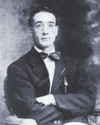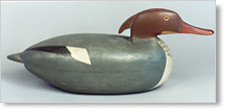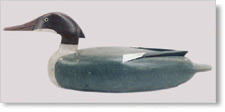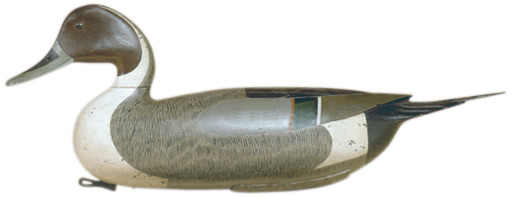by Allen Linkchorst
John English of Florence, New Jersey no doubt produced some of the finest decoys ever used on the Delaware River. His delicate hollow lures, with their lightly raised primaries and carefully incised wing and tail carving, clearly showcase his skills as one of the most talented makers of floating sculpture. If he wasn’t the innovator of the Delaware River style of decoy, he certainly was its early champion. Yet in the early recorded annuls of the history of decoys and their makers, due to the gifted brushstrokes of an avid duck hunter from nearby Trenton, his contributions were nearly overlooked.
| |
 |
| |
John Dawson
|
John Dawson, born on February 14, 1886, was from a family of early American settlers, descendants of the naval hero, John Paul Jones. During the Revolutionary War, the British blockaded the lower Delaware River denying the upriver ports of Wilmington, Delaware and Philadelphia with needed goods for trade and commerce. The colonials fought back with a tiny fleet of small ships, attacking and harassing the British blockade. A young John Paul Jones, serving aboard the Alfred, contributed to this war effort.
In 1909 Dawson married Rose Sandor, and they had four daughters - Margaret, Hazel, Julia and Mary. Shortly after his marriage he moved to 574 Centre Street, just down the street from his childhood home, and lived there for the remainder of his life.
Dawson worked at the Scammel Pottery Company on 3rd Street in Trenton as a kiln operator. With the exception of a brief period during World War II, when he worked at Roebling Steel, it was a job he performed for most of his life.
Dawson greatly appreciated the decoys he had been gifted by his uncle, as he used them throughout his lifetime of hunting. Yet he must have felt the rig, which had been hunted commercially by his uncle for years, was in need of sprucing up. Some of the decoys he stripped to the bare wood, others he simply painted over. If Dawson realized that the maker of the round, streamlined and graceful lures was John English of nearby Florence, now considered the designer of the Delaware River school of decoys, it’s doubtful it would have influenced his decision either way.
 |
|
Deep-bodied merganser hen with crest carving and a small triangular tail. The later Dawson decoys exhibit a Bordentown style of carving.
|
|
Using artist’s oils, Dawson painted the decoys in bold, geometric patterns that have a strong Art Nouveau influence, which was the height of fashion in those days. The objects produced in the pottery factory where he worked likely influenced his style. He certainly would have observed the artists painting the Art Nouveau designs in the factory, and possibly received pointers from these painters as well.
The geometric patterns on his decoys in no way resemble the real feathering on a duck, yet it produced a realistic looking decoy. Bob White, a noted carver and collector who gunned over dozens of English/Dawson decoys, insists “the decoys looked great on the water and really drew the ducks in.”
Of the approximately 70 to 75 English/Dawson decoys in the rig, they were made as black ducks, mallards, pintails, wigeons, redheads, goldeneyes, bluebills and canvasbacks. There are also a few mergansers that have been credited as the work of English/Dawson.
The decoys that Dawson personally carved and painted, chunkier birds that in no way resemble the refined carving style of John English decoys, are now referred to as Dawson/Dawson decoys. In many ways they are more reminding of the Bordentown style of decoys made by his friend Charles Black, who he often visited. His family remembers him drawing head and body patterns on pieces of pine and taking them to a local lumberyard where, for a small fee, they would rough out the patterns. He would return home and finish carving the decoys outside or at the kitchen table. He painted his decoys at night at the kitchen table.
The bodies of his hollow pine decoys are held together with white lead and nails. The seam floats above the waterline on all but his merganser “ice ducks,” which were used on the ice at the water’s edge to pass shoot during the winter. The deep, wide bodies are flat bottomed with a small triangular tail that lacks incising. Two dowels help hold the body halves together. All are fairly uniform in size and shape. Although the body has minimal detail, Dawson carved nostrils and lower mandibles and painted nails on the end of the bills. A rectangular lead pad weight is held in place by four brass screws and a leather loop served as the anchor line. He stamped a small JD on the bottoms of many of his decoys and painted a dark V underneath the bills. The majority of the Dawson/Dawson decoys in collections today show little or no gunning wear.
| |
 |
| |
Merganser hen with delicate crest vcarving, raised wings and a rounded paddle tail.
|
All of the Dawson/Dawson decoys are divers and all are in a straight-ahead position. Known species include redheads, bluebills, canvasbacks, mergansers and at least one bufflehead. All have quality German glass eyes, and all were yellow, except for the canvasbacks, which have small black eyes. All are well painted in his stylish, geometric designs, with the drakes having more elaborate patterns. Lloyd Johnson, an early decoy collector from Bayhead, New Jersey who admired the English/Dawson decoys, referred to him as a “pattern painter.”
Dawson’s passion for hunting mergansers must have influenced his experimentation with a wide diversity of carving and painting styles within this species. He produced at least five different body styles, ranging from 1½ to 4½ inches deep. Some bodies are short and round while others are long and thin. Three different crest styles are found on the mergansers, while others have no crest at all. Some mergansers have small triangular tails identical to the majority of his divers, and others have squared tails with carved notches. Some have carved raised wings and others have smooth backs. All have a racy attitude.
The most sought after Dawson/Dawson decoys are the flat-bodied “ice ducks” with the thin heads and geometric paint patterns. While they were constructed to sit on the solid ice packs surrounding the open water of the Delaware River in the late winter months, they could be floated if needed.
After his death in 1959, his wife sold his decoys. Ten silhouette plover decoys with small wooden bills and wire legs were found in the rig. Plovers and other shorebirds were hunted on the Delaware River, however they were never numerous enough to entice gunners to make shorebird decoys, thus they are extremely rare. Dawson would have been old enough to hunt shorebirds, but whether he carved them or received them from his Uncle’s rig will likely never be known. But they are definitely old and rare and exhibit legitimate gunning wear.

John Dawson received a rig of John English decoys from his uncle, a former market hunter, sometime around 1910. The rig needed sprucing up, so Dawson carefully repainted the decoys with skillfully executed combing and bold geometric patterns that display a striking influence to the Art Nouveau movement that was the style of the day, no doubt a technique employed by the painters at the pottery factory where he worked. The variety of species includes: (this page) pintails; and (top to bottom, facing page): black duck, goldeneye, redhead, wigeon and bluebill. There are also examples of English/Dawson mallards, canvasbacks and mergansers.
Special thanks to Mark Pisauro, Bob White, Harry Knowles and Mrs. Hazel Dawson for their assistance..
For the complete story, please see the Jan./Feb. 2003 issue of Decoy Magazine.
Tidbits Main Index

|


